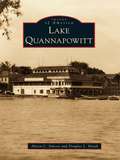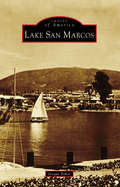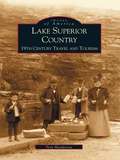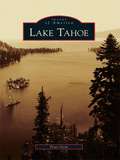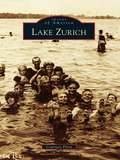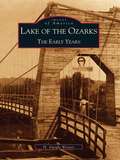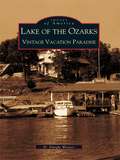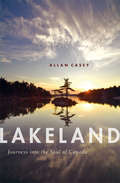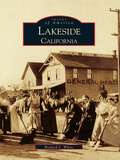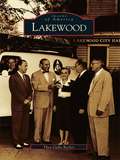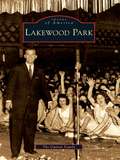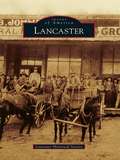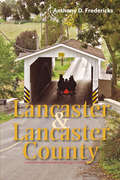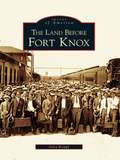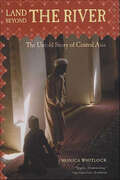- Table View
- List View
Lake Pontchartrain
by Catherine CampanellaNative Americans used Okwata, meaning "wide water," as a shortcut for inland trade between the Gulf of Mexico and the Mississippi River. When the Europeans arrived, the original inhabitants showed them the route--the settlement near the river became the city of New Orleans, other lakeshore communities grew, and Lake Pontchartrain continued to be a vital waterway well into the 20th century. Aside from its economic value, Lake Pontchartrain was a cultural mecca: Mark Twain wrote about it and jazz sprang from its shores; locals and visitors traveled out to the amusement parks and opera pavilions, simple fishing villages and swanky yacht clubs, forts and lighthouses; and majestic hotels and camps perched precariously over the water. In Images of America: Lake Pontchartrain, photographs document memories of a time that not even Hurricane Katrina could erase.
Lake Pontchartrain (Images of America)
by Catherine CampanellaIn Images of America: Lake Pontchartrain, photographs document memories of a time that not even Hurricane Katrina could erase.Native Americans used Okwata, meaning "wide water," as a shortcut for inland trade between the Gulf of Mexico and the Mississippi River. When the Europeans arrived, the original inhabitants showed them the route--the settlement near the river became the city of New Orleans, other lakeshore communities grew, and Lake Pontchartrain continued to be a vital waterway well into the 20th century. Aside from its economic value, Lake Pontchartrain was a cultural mecca: Mark Twain wrote about it and jazz sprang from its shores; locals and visitors traveled out to the amusement parks and opera pavilions, simple fishing villages and swanky yacht clubs, forts and lighthouses; and majestic hotels and camps perched precariously over the water.
Lake Quannapowitt
by Alison C. Simcox Douglas L. HeathLake Quannapowitt is named for James Quonopohit, a member of the Pawtucket tribe of Nipmuc Indians and signer of the 1686 deed selling land to European colonists. A town called Redding (now Wakefield) developed on the shore of the lake that provided colonists with a bounty of fish, including salmon and alewives, until mills stopped their passage upstream. The town remained rural until the Boston and Maine Railroad arrived in 1845. Overnight, new markets became accessible, and Lake Quannapowitt ice was exported to destinations worldwide. Icehouses dominated the shoreline and stood side-by-side with boathouses and bathhouses. Some in Wakefield remember the last days of ice harvesting, although barely a trace of its existence remains. More residents remember Hill's Boathouse and Dance Hall, where many a romance began. For recent arrivals who walk and jog its idyllic 5-kilometer shore, the lake's industrial and complex past will come as a surprise.
Lake Quinsigamond and White City Amusement Park (Images of America)
by Michael Perna Jr.In the 1800s and well into the 1900s, the area around Lake Quinsigamond, in Shrewsbury and Worcester, was one huge summer resort. Hotels, ethnic and social clubs, boat clubs, a horse racing track, picnic grounds, and two amusement parks, Lincoln Park and White City Park, lined the shore. Steamboats and smaller steam launches transported tourists to the area. Canoes, rowboats, sailboats, and motorboats crowded the lake on weekends. Crew boat regattas, which started in the 1850s, continue to this day. Lake Quinsigamond and White City Amusement Park lets readers experience the attractions, such as the shoot the chutes and White City roller coaster, and enjoy the fun atmosphere during those long-ago summers.
Lake San Marcos
by Jacque BakerIn 1962, the Frazar brothers purchased 1,648 acres of land, which included a 40-acre lake, in San Diego's North County with the goal of building a lakeside community of homes and two golf courses. By 1964, the lake was enlarged to 80 acres and the land was reshaped to accommodate 1,500 homes (eventually growing to over 2,500 homes); two golf courses, one a private country club and the other a public course; and a bridge across the lake. A motel, restaurant, shopping center, and residents' recreation center were later added. In 1967, the National Home Builders Association Convention in Chicago awarded the Lake San Marcos design the title of "Best Planned Lakeside Community in the Nation."
Lake Superior Country: 19th Century Travel and Tourism
by Troy HendersonWhat attracted 19th century travelers to the rugged landscape of Michigan's Upper Peninsula? Most travelers had to brave the frigid, gigantic, and the often-perilous Lake Superior to gain entrance to the Upper Peninsula. But although the lake and rugged terrain often made it difficult for travelers to traverse the Upper Peninsula, it also often made travel an adventurous and enjoyable occasion.Lake Superior Country: 19th Century Travel and Tourism to Michigan's Upper Peninsula will follow these 19th century travelers, from the explorers in search of land titles and valuable mineral deposits in the early part of the century, to "literary travelers" seeking to witness the romantic region made famous by Henry W. Longfellow's poem "The Song of Hiawatha," to the sportsmen and sportswomen who found a bounty of wildlife and fishing grounds. It will also illustrate the various methods of travel undertaken by these people, from birch bark canoes, to steamers, to the railroads, and how these different methods of travel defined the overall tourist experience.
Lake Tahoe: A Maritime History (Images of America)
by Peter GoinThe Washoe Indians called it Tah-ve, an unfathomable liquid sapphire set in a 500 square-mile watershed of alpine snow and ice. Too deep and vast to freeze, Lake Tahoe's waters have, over time, reflected pristine forests, barren hillsides littered with slash and sawdust, managed restoration, and the glow of neon casino marquees. Its spectacular natural landscape, shared by both California and Nevada, is more designed than people realize. Humans transformed most of the old trees into mine shafts and cities. When the railroad, and later the automobile, domesticated the lake, putting it within recreational reach of the middle class, much of Lake Tahoe's shore became a managed wilderness. Its location along a political border created a unique merger of naturalist and gaming economies.
Lake Tourism
by C. Michael Hall Tuija HärkönenLakes are an essential element of some of the world's most popular tourism destinations. However, increased pressure from visitors and the tourism industry as well as from other, sometimes competing, land and water uses has made the sustainable development of lakes increasingly problematic. This book represents the first attempt to bring together some of the key elements of lake tourism within a single volume in order to present the urgent need for an integrated approach to lacustrine tourism systems management.The book presents comprehensive overviews of lake tourism including branding and marketing, visitor management and planning, historical and cultural dimensions, and environmental quality. The volume is international in scope with cases from Europe, North America and Oceania. The book concludes by noting that tourism needs to be established as a complimentary land and water use at a time when lakes and their watersheds are facing challenges in the form of climate and environmental change, increasing numbers of visitors as well as an overall increase in competing demands for water.
Lake Wales (Images of America)
by Jan Privett Lake Wales Main StreetLake Wales, "Crown Jewel of the Scenic Highlands," is nestled among rolling hills and sparkling lakes in the geographic center of Florida. Before the 1900s, this area of the Lake Wales Ridge was considered spectacularly beautiful but uninhabitable because the virgin forests did not have road or railroad access. Only Native Americans and a few white hunters had camped there. G. V. Tillman explored the untamed area in 1902 and fell in love with the beauty. He knew that the land was ideal for citrus, the old-growth pines could provide profits from turpentine, and the natural beauty would attract quality settlers to build a quality town. He shared his vision with three other businessmen, and together they formed the Lake Wales Land Company in 1911. Their timing was perfect. The Atlantic Coast Line Railroad reached Lake Wales that year and brought on the boom time.
Lake Zurich (Images of America)
by Courtney FlynnLake Zurich, a northwest suburb of Chicago, includes a beloved body of water that shares its name and has served as its heart. But the lake did not always bear the same moniker. First known as Cedar Lake because of its many surrounding cedar trees, Lake Zurich was renamed by early settler Seth Paine, who thought its beauty resembled the well-known lake in Switzerland. Early on, visitors from Chicago and beyond journeyed by horse and buggy to relax by Lake Zurich's banks, fish and boat on its sparkling waters, and vacation in summer cottages that dotted its shores. But it has been the people of Lake Zurich who have kept its heart pumping. The celebration of their achievements is apparent throughout town. Parks are named after businessmen and local leaders like Fred Blau and Henry "Hank" Paulus. Schools' names highlight educators like May Whitney and Spencer Loomis. Lake Zurich's legacy will continue through its lake and the people who have loved it.
Lake of the Ozarks: The Early Years
by H. Dwight WeaverSeventy years ago in the Ozarks of southern Missouri, Bagnell Dam was built across the Osage River, creating the beautiful Lake of the Ozarks. Using over 200 images and in- depth captions, author H. Dwight Weaver takes readers back to the origins of this man-made treasure and the towns that surround it. Construction on Bagnell Dam began in 1929, employing thousands of men during the Great Depression. Inundation of the Osage River valley destroyed the area's most fertile farmlands, covered numerous historic sites, and even destroyed Linn Creek, the county seat. But the development also created new towns and a new economy. The images in this new book follow the growth of towns along U.S. Highway 54, including Eldon, Tuscumbia, Bagnell, Osage Beach, and Linn Creek, through the Depression, World War Two, and finally the booming 1950s.
Lake of the Ozarks: Vintage Vacation Paradise
by H. Dwight WeaverWhen the Union Electric Company finished constructing Bagnell Dam in 1931, they had done more than build a source of electrical power-they had created a vacation paradise. Bordered by lush hills and ancient bedrock, the Lake of the Ozarks covers more than 50,000 acres. Since the opening of the lake's first boat docks, three generations of visitors have spent countless days relaxing by its waters. H. Dwight Weaver reconstructs these lazy days, offering readers a vintage tour of one of America's favorite destinations. Each generation witnessed the area's growth, from rustic rock masonry buildings to gravity-defying mystery houses. While travelers in the 1930s and 40s came seeking respite from the Great Depression and World War II, their children and grandchildren returned in happier times, drawn back by the natural beauty and man-made wonders, as illustrated in these historic images.
Lakeland
by Allan CaseyLakes define not only Canada's landscape but the national imagination. Blending writing on nature, travel, and science, award-winning journalist Allan Casey systematically explores how the country's history and culture originates at the lakeshore. Lakeland describes a series of interconnected journeys by the author, punctuated by the seasons and the personalities he meets along the way including aboriginal fishery managers, fruit growers, boat captains, cottagers, and scientists. Together they form an evocative portrait of these beloved bodies of water and what they mean, from sapphire tarns above the Rocky Mountain tree line to the ponds of western Newfoundland.
Lakeland (Images of America)
by Lynn M. Homan Thomas ReillyMunnville, Rome City, and Redbug were just a few of the suggested names for the small Central Florida community that would come to be known as Lakeland. Not long after its founding, other descriptive monikers-"Lovely City of Lakes" and "Highest, Healthiest, Busiest"-would be applied. Recently ranked as the tenth "Best Place to Live" of medium-sized cities in the South, Lakeland today offers an entrancing combination of contrasting elements that all work well together. Fields of strawberries and rolling hills covered with citrus groves surround a growing city comprised of a mixture of structures, both new and old, modern and beautifully preserved. Commercial entities join with cultural organizations in mutually beneficial relationships to produce a quality of life that many other cities only hope to attain. Lakeland may well be as it was advertised in 1905-"Florida's Best Town."
Lakes and Ponds of the Granite State (Images of America)
by Bruce D. HealdNature chose to endow New Hampshire with an infinite variety of lakes and ponds, almost inexhaustible in resources and unlimited in beauty. Each lake holds its own fishing secrets, curving nooks, jagged rocks, and intricate shoreline. For generations, the lakes and ponds have wielded their magnetic force,attracting thousands of residents and visitors in every season of the year. Lakes and Ponds of the Granite State invites you to explore the many wonders of these charmed places. You will see the sun glancing off the wind-flecked surface, hear the breeze rustle the shoreward-bending trees, feel the coolness of the water, and eye a prized trout or two. You will encounter not only those lakes that come to mind first--Winnipesaukee, Sunapee, Squam, and Newfound--but nearly one hundred others, including Dublin and Spofford and the breathtaking Gloriette Lake.
Lakeside, California
by Richard S. WhitePurchased by the El Cajon Valley Land Company in 1886, Lakeside began as a small hamlet along the banks of the San Diego River. Home to the only natural lake in San Diego County, Lakeside offered visitors throughout the century a scenic backdrop for boating, fishing, hunting, riding, and hiking. Captured here in over 200 vintage images is the history of this town located just 25 miles east of San Diego. After the San Diego Mission was established in 1769, the Padres explored the backcountry, seeking grazing lands for their livestock. Following the San Diego River upstream they came to a broad valley, which they named El Cajon, "the box." In 1886, 6,600 acres were sold to the El Cajon Land Company for the Lakeside town site and a large inn was built as a resort. Due in large part to the trains coming through Lakeside in 1889, Lakeside had become a thriving community by the turn of the century.
Lakewood (Images of America)
by Thea Gallo BeckerNamed for its natural setting on the south shore of Lake Erie, Lakewood, Ohio was one of Cleveland's original suburbs. Incorporated as a city in 1911, Lakewood experienced tremendous growth during the early 20th century, and became known as "Cleveland's Fashionable Suburb," and a "City of Beautiful Homes," as it boasted some of the finest Victorian residences in the area. Using a wonderful collection of historic photographs, many from the Lakewood Historical Society, the pages of this book take you on a tour of Lakewood's history, chronicling the people, places, and events that have made the suburb one of the area's best places to live.
Lakewood Park (Images of America)
by The Guinan FamilySituated in the coal regions of northeast Pennsylvania, Lakewood Park was established in 1916 by the Guinan family as a place to bathe, picnic, and camp. It became known as a nature retreat for the nearby miners and their families, and it developed into the destination for swimming, amusement rides, skating, big band dances, boxing matches, ethnic celebrations, summer stock plays, and political banquets. The park boasted a 150-yard cement pool, hand-carved Spillman carousel, and grand ballroom. It was the host of the longest-running ethnic festival in Pennsylvania, Lithuanian Day, from 1914 to 1984. Using vintage images, Lakewood Park recalls the various festivals and celebrations, amusements rides, and celebrity performers, such as Dick Clark and Doris Day, that made the park an entertainment mecca for 68 years.
Lampedusa: Gateway to Europe
by Lidia Tilotta Dr Pietro Bartolo"Bartolo tells us about rescuing everyone he can, burying those he cannot, and saving their stories as if they were his own. This is a personal, urgent and universal book" GLORIA STEINEM"An urgent, wrenching dispatch from the frontline of the defining crisis of our times . . . Bartolo is at once the saviour and the coroner to boatload after boatload of migrants who risk everything to cross the deadly seas. It is also a damning indictment of the broader, collective indifference of humankind to both the drowned and the saved" PHILIP GOUREVITCH"Dr Pietro Bartolo has seen more suffering and death in his career than any one man should have to witness" Amnesty International"Through Bartolo we understand that it is impossible to do nothing in the face of such great human need" Vanity FairIt is common to think of the refugee crisis as a recent phenomenon, but Dr Pietro Bartolo, who runs the clinic on the Italian island of Lampedusa, has been caring for its victims - both the living and the dead - for a quarter of a century.Situated some 200 km off Italy's Southern coast, Lampedusa has hit the world headlines in recent years as the first port of call for hundreds of thousands of African and Middle Eastern migrants hoping to make a new life in Europe.The shipwrecks began in 1992. Before the Arab Spring, they came from Africa, but now they come from across the Arab world as well. And the death toll is staggering. On Christmas Eve, 1996, 286 bodies were recovered; on the night of October 3, 2003, 366 out of 500 migrants died after a shipwreck nearby.For the past twenty-five years, Doctor Bartolo has been rescuing, welcoming, helping, and providing medical assistance to those who survived. But, above all, he has been listening to them. Tales of pain and hope, stories of those who didn't make it, who died at sea, their bodies washed up on shore; stories of those who lost their loved ones, of babies that never had a chance to be born.SHORTLISTED FOR THE ITALIAN PROSE TRANSLATION AWARD (IPTA)Translated from the Italian by Chenxin Jiang
Lana'i
by Alberta De JetleyLong before neatly cultivated rows of pineapple fields stretched out as far as one could see, demon spirits are said to have made L?na'i uninhabitable for humans. The spirits were banished by a young man from L?haina who is credited with forming the first settlement on the island. Centuries later, in 1778, warriors battled on the island's steep cliffs and drove their enemies to their deaths. Every living thing was destroyed, all except for one man who saved himself by leaping off a cliff into the ocean and swimming to safety. Time heals, and the land endured. When winter storms turned barren slopes green again, the natives returned and were followed in later years by men who carved their names into the history of L?na'i.
Lancaster
by Lancaster Historical SocietyIn 1841, the Republic of Texas was on the brink of bankruptcy, and it needed to attract new immigrants in order to survive. With this important goal in mind, in 1844 the Texas congress authorized the republic's president, Sam Houston, to contract with individuals to colonize the state. In September of that same year, one group headed by Capt. Roderick Rawlins from Illinois came to Texas and settled in what would become the town of Lancaster. Farmers grew grains and cotton, and Lancaster became a trade center with a lively town square. A commercial club organized in order to coordinate advertising for local businesses, and it also held trade days that later became town fairs. Local residents worked hard all week and enjoyed horse races, baseball, "forty-two" parties, music performances, and other entertainment on the weekends. By the late 1800s, Lancaster was connected to the rest of the state by the railroads, but the town still retained its independent, small-town Texas character.
Lancaster (Images of America)
by Connie L. Rutter Sondra Brockway GartnerLancaster, Ohio, with a population of around 35,000, sits snuggled among the rolling hills at the base of a sandstone bluff that the Wyandot Indians called "Standing Stone." Just east of the Hock-Hocking River in Fairfield County and a few miles southeast of Columbus, Lancaster was founded on November 10, 1800, by Col. Ebenezer Zane (1747-1811). The city's rich history is celebrated today in one of the most significant historic districts in the Midwest, known as Square 13. The city offers a walking tour of the area, originally designed in 1800. In a 24-block area, 89 buildings have been designated on the National Register of Historic Places, and the Sherman House Museum is listed as a National Historical Landmark.
Lancaster and Lancaster County: A Traveler's Guide to Pennsylvania Dutch Country
by Anthony D. FredericksThis complete guide, devoted solely to Pennsylvania Dutch Country, will prove invaluable to first-time and return visitors alike. Drawing from the rich palette of things to see and experience in this colorful region, Fredericks supplies all the necessary how and where information while guiding the reader to its best offerings for a memorable experience. More than 11 million visitors come to Lancaster County, Pennsylvania, every year. A quintessential vacation destination, it represents a return to simpler times and a slower lifestyle. Author Anthony Fredericks knows the region well, and Lancaster and Lancaster County includes all the information you'll need to explore here, including history, transportation, recreation, shopping, and then some. Fredericks's in-depth knowledge of Pennsylvania Dutch Country fills these pages with invaluable insights and provides you with all the help you need to plan a thoroughly enjoyable and enriching visit.
Land Before Fort Knox, The (Images of America)
by Gary KempfLocated south of the Ohio River and Louisville, Kentucky, the Fort Knox military installation is the location for the training of U.S. Army Armor and Cavalry forces. Known as the home of Mounted Warfare, Fort Knox is also the location of the U.S. Treasury Department Gold Vault that opened in February 1937. Fort Knox covers 178 square miles and spans parts of Hardin, Meade, and Bullitt Counties. The area was once home to Thomas Lincoln, father of the nation's martyred 16th president, as well as the burial place of Abraham Lincoln's grandmother, Bathsheba Lincoln. Images of America: The Land Before Fort Knox illuminates the past while images bring to light people and places of yesterday.
Land Beyond the River: The Untold Story of Central Asia
by Monica WhitlockAlong the banks of the river once called Oxus lie the heartlands of Central Asia: Uzbekistan and Tajikistan. Catapulted into the news by events in Afghanistan, just across the water, these strategically important, intriguing and beautiful countries remain almost completely unknown to the outside world. In this book, Monica Whitlock goes far beyond the headlines. Using eyewitness accounts, unpublished letters and firsthand reporting, she enters into the lives of the Central Asians and reveals a dramatic and moving human story unfolding over three generations.There is Muhammadjan, called 'Hindustani', a diligent seminary student in the holy city of Bukhara until the 1917 revolution tore up the old order. Exiled to Siberia as a shepherd and then conscripted into the Red Army, he survived to become the inspiration for a new generation of clerics. Henrika was one of tens of thousands of Poles who walked and rode through Central Asia on their way to a new life in Iran, where she lives to this day. Then there were the proud Pioneer children who grew up in the certainty that the Soviet Union would last forever, only to find themselves in a new world that they had never imagined. In Central Asia, the extraordinary is commonplace and there is not a family without a remarkable story to tell.Land Beyond the River is both a chronicle of a century and a clear-eyed, authoritative view of contemporary events.


